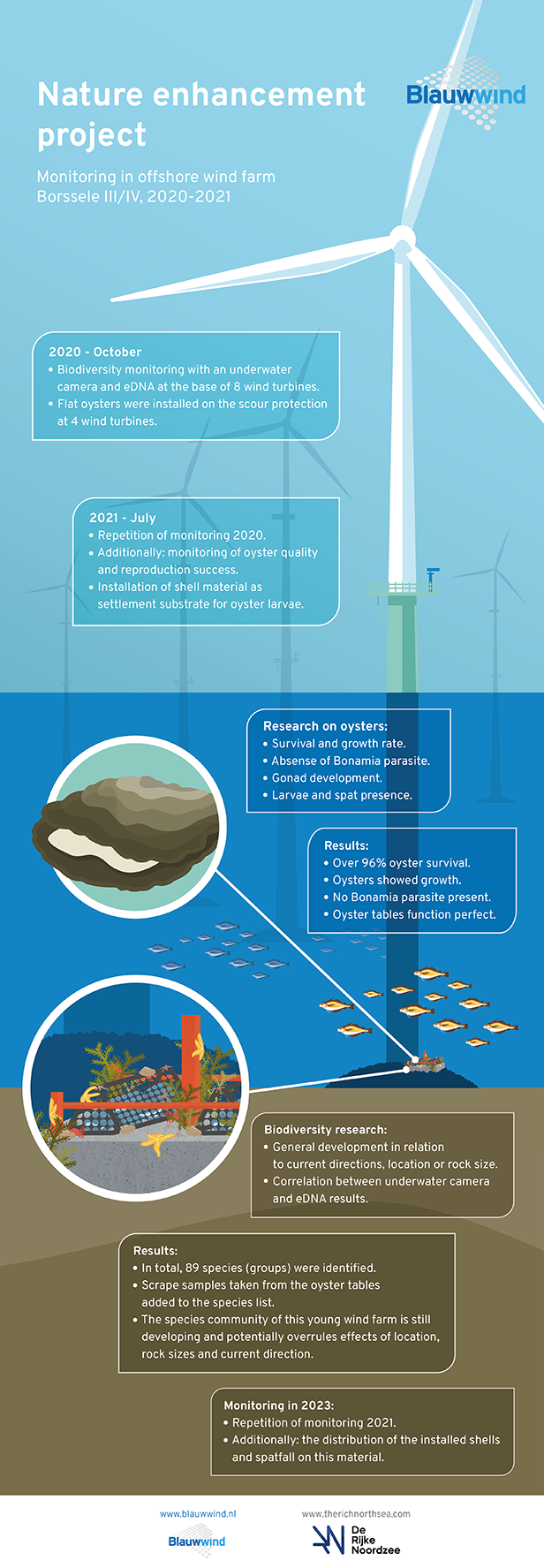
Nature enhancement project
The Borssele III and IV wind farms were designed to enhance biodiversity in the North Sea. An eight-year nature improvement project is currently taking place to monitor biodiversity at these sites in collaboration with the Rich North Sea programme. A monitoring pilot began in October 2020.
It investigated whether oysters could establish themselves sustainably at the sites and examined the potential for attracting new marine life. The pilot involved placing oyster tables with more than 2,400 oysters at the base of the wind turbines at four locations.
The latest monitoring operation took place in July 2021. A number of key questions were addressed during the survey, including the following.
- What are the survival and growth rates of flat oysters?
- Do the flat oysters produce larvae?
- Do the flat oysters stay free of the parasite Bonamia?
- How is biodiversity in general developing on the different substrate variations?
- Are there species-specific responses to current directions or rock size in relation to the scour?
- Are species data – found by ROV (remotely operated vehicle) video and photo analyses – and environmental DNA data correlated?
- Which species are not detected or only detected by certain methods?
Monitoring involved measuring growth of the oysters, taking water samples for larvae and environmental DNA analysis, obtaining oyster samples from the baskets (for reproduction and Bonamia status) and a combined video and photo survey of scour protection with an ROV. Shell material was also placed at the locations to stimulate biodiversity.
Blauwwind and Rich North Sea scientists completed the operation using the Isle of Jura utility vessel, supported by Van Oord. The work was safely carried out at eight locations over a three- to four-day period. Detailed steps were developed to ensure proper sampling of DNA and for assessing conditions. Clear instructions were also given for the ROV to acquire the best images in the correct areas.

The results
Data analysis took place in the months following the on-site monitoring. The headline results were very positive: more than 96% of the oysters survived the winter since installation of the oyster tables in late 2020. Oysters had grown in size and Bonamia was not detected. The oyster tables had remained stable and have been safely re-installed ahead of the next monitoring operation planned for 2023.
A wide variety of marine species were found in and around the oyster tables. Qualitative investigations of fauna from scrape samples and on oyster shells indicate that the oysters (or at least the oyster tables) enable a rich marine life. Species were identified across different groups – ranging from crustaceans to fish and molluscs.
Unfortunately, oyster larvae were not found during the 2021 operation, and DNA analysis was not fully successful. DNA was resampled in 2022, and monitoring will focus on larvae in 2023.
The ROV images reinforced the positive findings on marine biodiversity. In 2021, the team observed a small increase in the number of species captured by image and video compared to the footage of 2020.
Overall, the results are very encouraging, and both Blauwwind and Rich North Sea look forward to continuing their cooperation during the next monitoring operation in 2023.